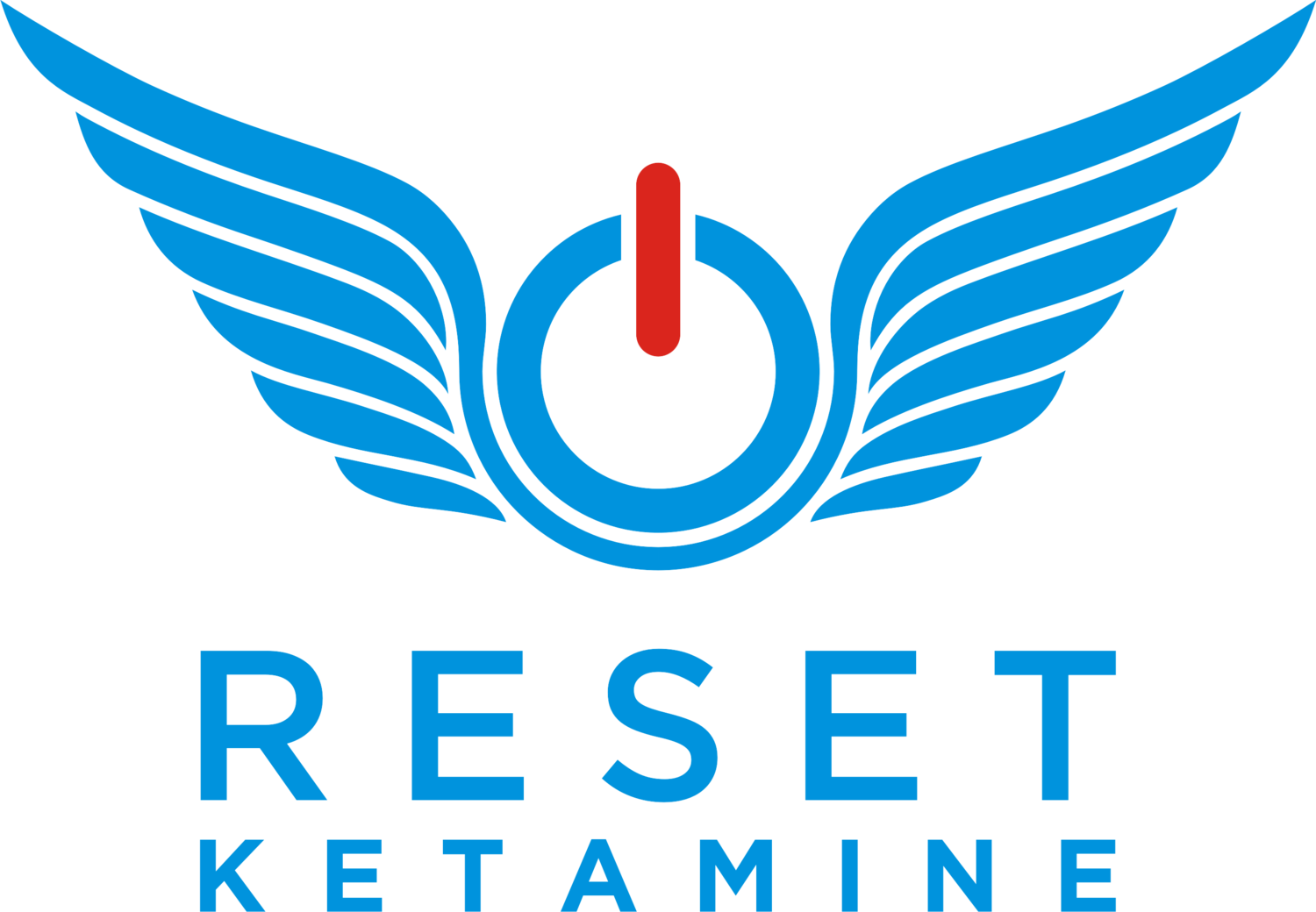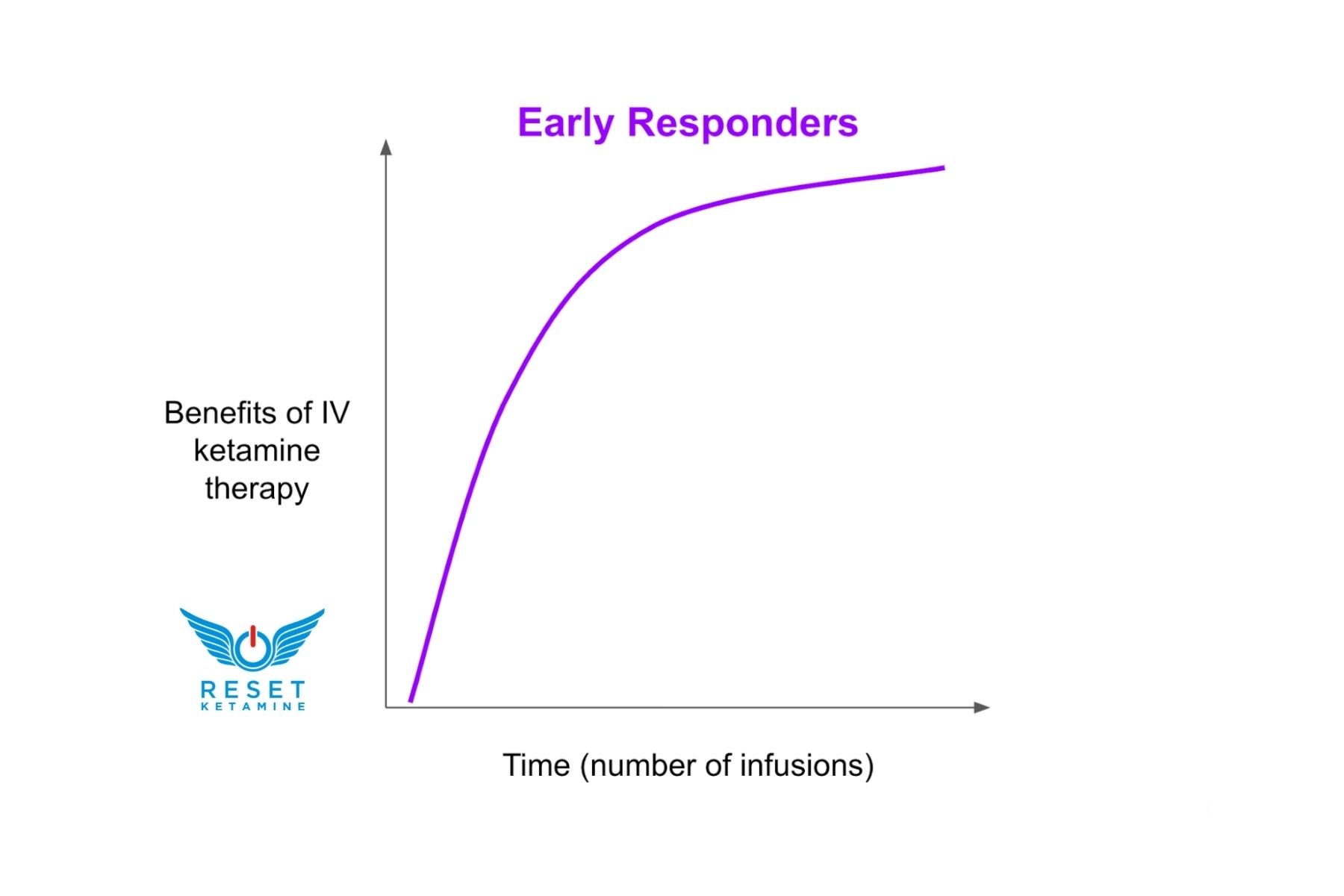This blog post has been adapted from the transcription of the above video.
One of the questions that I get asked about frequently is, "How long will it take for me to know whether I am responding to ketamine infusions or not?" To answer this question, I made a quick little graph to explain to you the different types of responses that someone can have. On this graph, you can find the benefits from IV ketamine therapy on the y-axis and time on the x-axis. Whenever someone receives ketamine infusions, they fall into one of the four categories: early responders, late responders, standard responders, and non-responders. In this blog, we’ll discuss each one!
Early Responders
Early responders are patients that usually respond pretty well during the first few infusions then plateau later on.
Let's look at the first group which I call the early responders. Notice how the graph above goes up quite fast and then kind of tapers out at the end. I call these patients Early Responders because within the first one to two treatments, they're getting significant benefits. Whether it's a drop in their depression, PTSD, or pain scores.
What happens if your symptoms could be plateauing after receiving several infusions? Read our blog Why Your Symptoms Maybe Plateauing With Ketamine Infusions.
Standard Responders
Standard responders experience gradual improvements in their systems as the treatment progresses.
In this graph above, you’ll notice that the blue line is just a straight diagonal line. This is what I call the Standard Responder. Usually within two, three, or four treatments, that's when they gradually notice an incremental improvement in their symptoms.
Late Responders
Late responders take a while to respond to ketamine treatments so their progress is slow in the beginning before noticing any significant benefits later on.
If you look at the graph above, you'll see another line, which I will refer to as the Late Responders. What you'll notice in this line is that the patients don't really get benefits initially and it takes a bit of time. Progress is slow and steady. And then near the latter portion, that's when they notice the benefits. For some people, it can take four to five treatments before they notice any benefits from IV ketamine therapy.
Non-responders
None-responders don’t experience much benefits from ketamine infusions.
Finally, let's look at this fourth case, which is kind of like a straight line down at the very bottom. Although ketamine therapy is quite effective, it doesn't work in some cases. Some studies are reporting anywhere from 20 to 30 percent of patients who we refer to as Non-responders. These patients, even with ketamine therapy, don’t really get any benefits from their treatment.
If you’re also wondering whether your age affects how well you respond to ketamine, read our blog to learn more.
Everyone Is Different, And That’s Okay
One of the things we do here at Reset Ketamine is measurement based care. What happens is that before each infusion, someone comes in and they're going to fill out various surveys. We first look at their depression score, anxiety score, or PTSD score, depending on what they’re focusing on. From there, we can tell whether they are a Responder, an Early Responder, a Standard Responder, or a Late Responder, or even a Non-responder, which can definitely happen.
Each individual responds to ketamine differently, but following proper preparation and integration could positively affect your ketamine experience.
This graph above helps you compare all different cases. You can see the various responses and the benefits over time depending upon whether someone is an Early Responder, Late Responder, Standard Responder, or Non-responder.
Although everyone does indeed respond to ketamine differently, you also get to play a vital role in making your ketamine experience as transformative as possible. By incorporating good habits and setting an intention before your treatment, and having proper integration after the experience, you have the power to influence how you respond to ketamine.
We’re listing all the possibilities of responding to ketamine not to discourage you, but in order for you to prepare and be aware. At the end of the day, whatever you are going to experience is what you are meant to experience!
If you are unsure whether ketamine is right for you or not, we are here to guide you.
Common Related Questions:
Why would I be a non-responder?
It can be caused by a lot of factors. Your results can be related to your medications, ketamine dose, how you prepared for the treatment, the set and setting of the treatment, integration (or lack of), the number of sessions you have undergone, or ketamine may simply not be for you. Below is a video that goes over this very topic, or if you prefer to read about it, head over to our blog post 7 Reasons Why Your Ketamine Treatments Aren’t Working.
Don’t I just need a higher dose (amount) of ketamine to get a better response to the treatment?
Typical dosing for mood disorder treatments start at 0.5 mg/kg and then is increased, depending upon patient effect and safe vital sign assessments. We believe (plus research supports) higher doses will lead to non-ordinary states of consciousness, which may lead to a more potent, profound, and prolonged effect.
That being said, more doesn’t always mean better. We’ve had some patients who have had such a high dose, they couldn’t remember or navigate their ketamine experience. Interestingly, some patients don’t need higher doses either to have a profound effect. Each patient is different, so a tailored dose specifically for that person is needed to achieve the maximal benefits.
Ketamine alone doesn’t make a person better. We’ve seen that patients who make changes in their everyday life, in conjunction with their treatments, respond the best! Explore more about how to maximize your response to ketamine here.
If I get better with ketamine, does that mean I don’t have to take medications?
You’ll likely continue to take medications or decrease the amount you take under the supervision of your doctor. While it is important to remember that each individual has a unique medical history and responds in their own way to ketamine infusions, there are some who have the potential to no longer need certain medications like SSRIs or benzodiazepines.
However, more often than not, what we see is that some patients will need less of a dosage. Others are able to get off some, but not all medications, related to the disorder they are getting treated with ketamine infusions for. Regardless, any changing or stopping of medications should be done under the supervision of the prescribing or primary doctor and often done slowly, tapering the medication.
This expectation, similar to the previous two expectations, is rooted in a mis-guided hope that ketamine is the only answer and is a miracle drug. Yes, ketamine can do miraculous things for patients BUT the fantastic transformation comes with a holistic approach to the treatment and individual.
Explore more expectations vs realities of getting ketamine treatments here!









